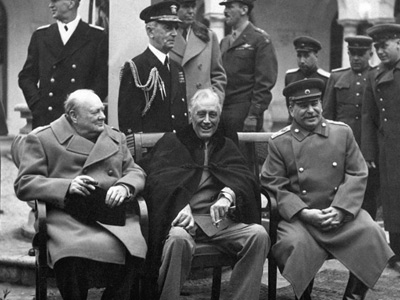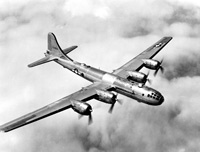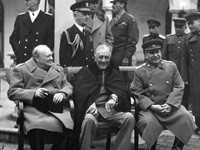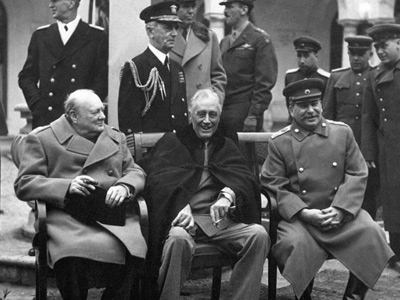Cold War (1947–1991)

Confrontation through Détente (1962–1979)
In the course of the 1960s and 1970s, Cold War participants struggled to adjust to a new, more complicated pattern of international relations in which the world was no longer divided into two clearly opposed blocs. From the beginning of the post-war period, Western Europe and Japan rapidly recovered from the destruction of World War II and sustained strong economic growth through the 1950s and 1960s, with per capita GDPs approaching those of the United States The United States of America (U.S.A. or USA), commonly known as the United States (U.S. or US) or America, is a country in North America. It is the world's third-largest country by both land and total area. The United States shares land borders with Canada to its north and with Mexico to its south. The national capital is Washington, D.C., and the most populous city and financial center is New York City., while Eastern Bloc economies stagnated.
The United States of America (U.S.A. or USA), commonly known as the United States (U.S. or US) or America, is a country in North America. It is the world's third-largest country by both land and total area. The United States shares land borders with Canada to its north and with Mexico to its south. The national capital is Washington, D.C., and the most populous city and financial center is New York City., while Eastern Bloc economies stagnated.
As a result of the 1973 oil crisis, combined with the growing influence of Third World alignments such as the Organization of Petroleum Exporting Countries (OPEC) and the Non-Aligned Movement, less-powerful countries had more room to assert their independence and often showed themselves resistant to pressure from either superpower. Meanwhile, Moscow was forced to turn its attention inward to deal with the Soviet Union's Soviet Union, officially the Union of Soviet Socialist Republics (USSR), was a transcontinental country that spanned much of Eurasia from 1922 to 1991. The Soviet Union fall process began with growing unrest in the Union's various constituent national republics developing into an incessant political and legislative conflict between them and the central government. Estonia was the first Soviet republic to declare state sovereignty inside the Union. deep-seated domestic economic problems. During this period, Soviet leaders such as Leonid Brezhnev and Alexei Kosygin embraced the notion of détente.
Soviet Union, officially the Union of Soviet Socialist Republics (USSR), was a transcontinental country that spanned much of Eurasia from 1922 to 1991. The Soviet Union fall process began with growing unrest in the Union's various constituent national republics developing into an incessant political and legislative conflict between them and the central government. Estonia was the first Soviet republic to declare state sovereignty inside the Union. deep-seated domestic economic problems. During this period, Soviet leaders such as Leonid Brezhnev and Alexei Kosygin embraced the notion of détente.
French withdrawal from NATO
The unity of NATO was breached early in its history, with a crisis occurring during Charles de Gaulle's presidency of France France, officially the French Republic is transcontinental country predominantly located in Western Europe and spanning overseas regions and territories in the Americas and the Atlantic, Pacific and Indian Oceans. France reached its political and military zenith in the early 19th century under Napoleon Bonaparte, subjugating much of continental Europe and establishing the First French Empire. from 1958 onwards. De Gaulle protested at the United States' strong role in the organization and what he perceived as a special relationship between the United States and the United Kingdom
France, officially the French Republic is transcontinental country predominantly located in Western Europe and spanning overseas regions and territories in the Americas and the Atlantic, Pacific and Indian Oceans. France reached its political and military zenith in the early 19th century under Napoleon Bonaparte, subjugating much of continental Europe and establishing the First French Empire. from 1958 onwards. De Gaulle protested at the United States' strong role in the organization and what he perceived as a special relationship between the United States and the United Kingdom The British Empire, was composed of the dominions, colonies, protectorates, mandates, and other territories ruled or administered by the United Kingdom and its predecessor states. At its height it was the largest empire in history and, for over a century, was the foremost global power. By the start of the 20th century, Germany and the United States had begun to challenge Britain's economic lead.. In a memorandum sent to President Dwight D. Eisenhower and Prime Minister Harold Macmillan on 17 September 1958, he argued for the creation of a tripartite directorate that would put France on an equal footing with the United States and the United Kingdom, and also for the expansion of NATO's coverage to include geographical areas of interest to France, most notably French Algeria, where France was waging a counter-insurgency and sought NATO assistance.
The British Empire, was composed of the dominions, colonies, protectorates, mandates, and other territories ruled or administered by the United Kingdom and its predecessor states. At its height it was the largest empire in history and, for over a century, was the foremost global power. By the start of the 20th century, Germany and the United States had begun to challenge Britain's economic lead.. In a memorandum sent to President Dwight D. Eisenhower and Prime Minister Harold Macmillan on 17 September 1958, he argued for the creation of a tripartite directorate that would put France on an equal footing with the United States and the United Kingdom, and also for the expansion of NATO's coverage to include geographical areas of interest to France, most notably French Algeria, where France was waging a counter-insurgency and sought NATO assistance.
Considering the response given to be unsatisfactory, de Gaulle began the development of an independent French nuclear deterrent and in 1966 withdrew from NATO's military structures and expelled NATO troops from French soil.
Invasion of Czechoslovakia
In 1968, a period of political liberalization in Czechoslovakia called the Prague Spring took place that included "Action Program" of liberalizations, which described increasing freedom of the press, freedom of speech and freedom of movement, along with an economic emphasis on consumer goods, the possibility of a multiparty government, limiting the power of the secret police and potentially withdrawing from the Warsaw Pact.
In answer to the Prague Spring, on 20 August 1968, the Soviet Army, together with most of their Warsaw Pact allies, invaded Czechoslovakia. The invasion was followed by a wave of emigration, including an estimated 70,000 Czechs and Slovaks initially fleeing, with the total eventually reaching 300,000. The invasion sparked intense protests from Yugoslavia, Romania, China, and from Western European communist parties.
Brezhnev Doctrine
In September 1968, during a speech at the Fifth Congress of the Polish United Workers' Party one month after the invasion of Czechoslovakia, Brezhnev outlined the Brezhnev Doctrine, in which he claimed the right to violate the sovereignty of any country attempting to replace Marxism–Leninism with capitalism. During the speech, Brezhnev stated:
When forces that are hostile to socialism try to turn the development of some socialist country towards capitalism, it becomes not only a problem of the country concerned, but a common problem and concern of all socialist countries.
The doctrine found its origins in the failures of Marxism–Leninism in states like Poland Poland, officially the Republic of Poland, and in historical context referred to as the Third Polish Republic, is a country in Central Europe. The Kingdom of Poland emerged in 1025 and in 1569 cemented its longstanding association with Lithuania, thus forming the Polish–Lithuanian Commonwealth. It was one of the largest great powers of Europe at the time, with a uniquely liberal political system that adopted Europe's first modern constitution in 1791., Hungary and East Germany, which were facing a declining standard of living contrasting with the prosperity of West Germany and the rest of Western Europe.
Poland, officially the Republic of Poland, and in historical context referred to as the Third Polish Republic, is a country in Central Europe. The Kingdom of Poland emerged in 1025 and in 1569 cemented its longstanding association with Lithuania, thus forming the Polish–Lithuanian Commonwealth. It was one of the largest great powers of Europe at the time, with a uniquely liberal political system that adopted Europe's first modern constitution in 1791., Hungary and East Germany, which were facing a declining standard of living contrasting with the prosperity of West Germany and the rest of Western Europe.
Third World Escalations
Under the Lyndon B. Johnson Administration, which gained power after the assassination of John F. Kennedy, the U.S. took a more hardline stance on Latin America—sometimes called the "Mann Doctrine". In 1964, the Brazilian military overthrew the government of president João Goulart with U.S. backing. In late April 1965, the U.S. sent some 22,000 troops to the Dominican Republic for a one-year occupation in an invasion codenamed Operation Power Pack, citing the threat of the emergence of a Cuban-style revolution in Latin America. Héctor García-Godoy acted as provisional president, until conservative former president Joaquín Balaguer won the 1966 presidential election against non-campaigning former President Juan Bosch. Activists for Bosch's Dominican Revolutionary Party were violently harassed by the Dominican police and armed forces.
In Indonesia, the hardline anti-communist General Suharto wrested control of the state from his predecessor Sukarno in an attempt to establish a "New Order". From 1965 to 1966, with the aid of the United States and other Western governments, the military led the mass killing of more than 500,000 members and sympathizers of the Indonesian Communist Party and other leftist organizations, and detained hundreds of thousands more in prison camps around the country under extremely inhumane conditions. A top-secret CIA report stated that the massacres "rank as one of the worst mass murders of the 20th century, along with the Soviet purges of the 1930s, the Nazi mass murders during the Second World War World War II or the Second World War, often abbreviated as WWII or WW2, was a world war that lasted from 1939 to 1945. It involved the vast majority of the world's countries—including all of the great powers—forming two opposing military alliances: the Allies and the Axis powers. World War II was a total war that directly involved more than 100 million personnel from more than 30 countries. World War II is generally considered to have begun on 1 September 1939, when Nazi Germany, under Adolf Hitler, invaded Poland. View World War II », and the Maoist bloodbath of the early 1950s." These killings served U.S. strategic interests and constitute a major turning point in the Cold War as the balance of power shifted in Southeast Asia.
World War II or the Second World War, often abbreviated as WWII or WW2, was a world war that lasted from 1939 to 1945. It involved the vast majority of the world's countries—including all of the great powers—forming two opposing military alliances: the Allies and the Axis powers. World War II was a total war that directly involved more than 100 million personnel from more than 30 countries. World War II is generally considered to have begun on 1 September 1939, when Nazi Germany, under Adolf Hitler, invaded Poland. View World War II », and the Maoist bloodbath of the early 1950s." These killings served U.S. strategic interests and constitute a major turning point in the Cold War as the balance of power shifted in Southeast Asia.
Escalating the scale of American intervention in the ongoing conflict between Ngô Đình Diệm's South Vietnamese government and the communist National Front for the Liberation of South Vietnam (NLF) insurgents opposing it, Johnson deployed some 575,000 troops in Southeast Asia to defeat the NLF and their North Vietnamese allies in the Vietnam War, but his costly policy weakened the US economy and, by 1975, it ultimately culminated in what most of the world saw as a humiliating defeat of the world's most powerful superpower at the hands of one of the world's poorest nations.
In Chile, the Socialist Party candidate Salvador Allende won the presidential election of 1970, becoming the first democratically elected Marxist to become president of a country in the Americas. The CIA targeted Allende for removal and operated to undermine his support domestically, which contributed to a period of unrest culminating in General Augusto Pinochet's coup d'état on 11 September 1973. Pinochet consolidated power as a military dictator, Allende's reforms of the economy were rolled back, and leftist opponents were killed or detained in internment camps under the Dirección de Inteligencia Nacional (DINA). The Pinochet regime would go on to be one of the leading participants in Operation Condor, an international campaign of political assassination and state terrorism organized by right-wing military dictatorships in the Southern Cone of South America that was covertly supported by the US government.
The Middle East remained a source of contention. Egypt, which received the bulk of its arms and economic assistance from the USSR, was a troublesome client, with a reluctant Soviet Union feeling obliged to assist in both the 1967 Six-Day War (with advisers and technicians) and the War of Attrition (with pilots and aircraft) against pro-Western Israel. Despite the beginning of an Egyptian shift from a pro-Soviet to a pro-American orientation in 1972 (under Egypt's new leader Anwar Sadat), rumors of imminent Soviet intervention on the Egyptians' behalf during the 1973 Yom Kippur War brought about a massive American mobilization that threatened to wreck détente. Although pre-Sadat Egypt had been the largest recipient of Soviet aid in the Middle East, the Soviets were also successful in establishing close relations with communist South Yemen, as well as the nationalist governments of Algeria and Iraq. Iraq signed a 15-year Treaty of Friendship and Cooperation with the Soviet Union in 1972. According to historian Charles R. H. Tripp, the treaty upset "the U.S.-sponsored security system established as part of the Cold War in the Middle East. It appeared that any enemy of the Baghdad regime was a potential ally of the United States." In response, the U.S. covertly financed Kurdish rebels led by Mustafa Barzani during the Second Iraqi–Kurdish War; the Kurds were defeated in 1975, leading to the forcible relocation of hundreds of thousands of Kurdish civilians. Indirect Soviet assistance to the Palestinian side of the Israeli–Palestinian conflict included support for Yasser Arafat's Palestine Liberation Organization (PLO).
In Africa, Somali army officers led by Siad Barre carried out a bloodless coup in 1969, creating the socialist Somali Democratic Republic. The Soviet Union vowed to support Somalia. Four years later, the pro-American Ethiopian Emperor Haile Selassie was overthrown in a 1974 coup by the Derg, a radical group of Ethiopian army officers led by the pro-Soviet Mengistu Haile Mariam, who built up relations with the Cubans and the Soviets. When fighting between the Somalis and Ethiopians broke out in the 1977–1978 Somali-Ethiopian Ogaden War, Barre lost his Soviet support and turned to the Safari Club—a group of pro-American intelligence agencies including Iran, Egypt, and Saudi Arabia—for support and weapons. The Ethiopian military was supported by Cuban soldiers along with Soviet military advisors and armaments.
The 1974 Portuguese Carnation Revolution against the authoritarian Estado Novo returned Portugal to a multi-party system and facilitated the independence of the Portuguese colonies Angola and East Timor. In Africa, where Angolan rebels had waged a multi-faction independence war against Portuguese rule since 1961, a two-decade civil war replaced the anti-colonial struggle as fighting erupted between the communist People's Movement for the Liberation of Angola (MPLA), backed by the Cubans and the Soviets, and the National Liberation Front of Angola (FNLA), backed by the United States, the People's Republic of China, and Mobutu's government in Zaire. The United States, the apartheid government of South Africa, and several other African governments also supported a third faction, the National Union for the Total Independence of Angola (UNITA). Without bothering to consult the Soviets in advance, the Cuban government sent a number of combat troops to fight alongside the MPLA. Foreign mercenaries and a South African armoured column were deployed to support UNITA, but the MPLA, bolstered by Cuban personnel and Soviet assistance, eventually gained the upper hand.
During the Vietnam War, North Vietnam invaded and occupied parts of Cambodia to use as military bases, which contributed to the violence of the Cambodian Civil War between the pro-American government of Lon Nol and communist Khmer Rouge insurgents. Documents uncovered from the Soviet archives reveal that the North Vietnamese invasion of Cambodia in 1970 was launched at the request of the Khmer Rouge after negotiations with Nuon Chea. US and South Vietnamese forces responded to these actions with a bombing campaign and ground incursion, the effects of which are disputed by historians. Under the leadership of Pol Pot, the Khmer Rouge would eventually kill 1–3 million Cambodians in the killing fields, out of a 1975 population of roughly 8 million. Martin Shaw described these atrocities as "the purest genocide of the Cold War era." Backed by the Kampuchean United Front for National Salvation, an organization of Khmer pro-Soviet Communists and Khmer Rouge defectors led by Heng Samrin, Vietnam invaded Cambodia on 22 December 1978. The invasion succeeded in deposing Pol Pot, but the new state would struggle to gain international recognition beyond the Soviet Bloc sphere —despite the previous international outcry at Pol Pot's DK regime's gross human rights violations, and it would be bogged down in a guerrilla war led from refugee camps located in the border with Thailand. Following Khmer Rouge's destruction, Cambodia's national reconstruction would be severely hampered and Vietnam would suffer a punitive Chinese attack.
Sino-American Rapprochement
As a result of the Sino-Soviet split, tensions along the Chinese–Soviet border reached their peak in 1969, and United States President Richard Nixon decided to use the conflict to shift the balance of power towards the West in the Cold War. The Chinese had sought improved relations with the Americans in order to gain advantage over the Soviets as well.
In February 1972, Nixon announced a stunning rapprochement with Mao's China by traveling to Beijing and meeting with Mao Zedong and Zhou Enlai. At this time, the USSR achieved rough nuclear parity with the United States; meanwhile, the Vietnam War both weakened America's influence in the Third World and cooled relations with Western Europe. Although indirect conflict between Cold War powers continued through the late 1960s and early 1970s, tensions were beginning to ease.
Nixon, Brezhnev, and Détente
Following his visit to China, Nixon met with Soviet leaders, including Brezhnev in Moscow. These Strategic Arms Limitation Talks resulted in two landmark arms control treaties: SALT I, the first comprehensive limitation pact signed by the two superpowers, and the Anti-Ballistic Missile Treaty, which banned the development of systems designed to intercept incoming missiles. These aimed to limit the development of costly anti-ballistic missiles and nuclear missiles.
Nixon and Brezhnev proclaimed a new era of "peaceful coexistence" and established the groundbreaking new policy of détente (or cooperation) between the two superpowers. Meanwhile, Brezhnev attempted to revive the Soviet economy, which was declining in part because of heavy military expenditures. Between 1972 and 1974, the two sides also agreed to strengthen their economic ties, including agreements for increased trade. As a result of their meetings, détente would replace the hostility of the Cold War and the two countries would live mutually.
Meanwhile, these developments coincided with the "Ostpolitik" of West German Chancellor Willy Brandt. Other agreements were concluded to stabilize the situation in Europe, culminating in the Helsinki Accords signed at the Conference on Security and Co-operation in Europe in 1975.
Late 1970s Deterioration of Relations
In the 1970s, the KGB, led by Yuri Andropov, continued to persecute distinguished Soviet personalities such as Aleksandr Solzhenitsyn and Andrei Sakharov, who were criticising the Soviet leadership in harsh terms. Indirect conflict between the superpowers continued through this period of détente in the Third World, particularly during political crises in the Middle East, Chile, Ethiopia, and Angola.
Although President Jimmy Carter tried to place another limit on the arms race with a SALT II agreement in 1979, his efforts were undermined by the other events that year, including the Iranian Revolution and the Nicaraguan Revolution, which both ousted pro-US regimes, and his retaliation against Soviet intervention in Afghanistan in December.
HISTORY

RESOURCES
This article uses material from the Wikipedia article "Cold War (1947–1991)", which is released under the Creative Commons Attribution-Share-Alike License 3.0.
© Stories Preschool. All Rights Reserved.









